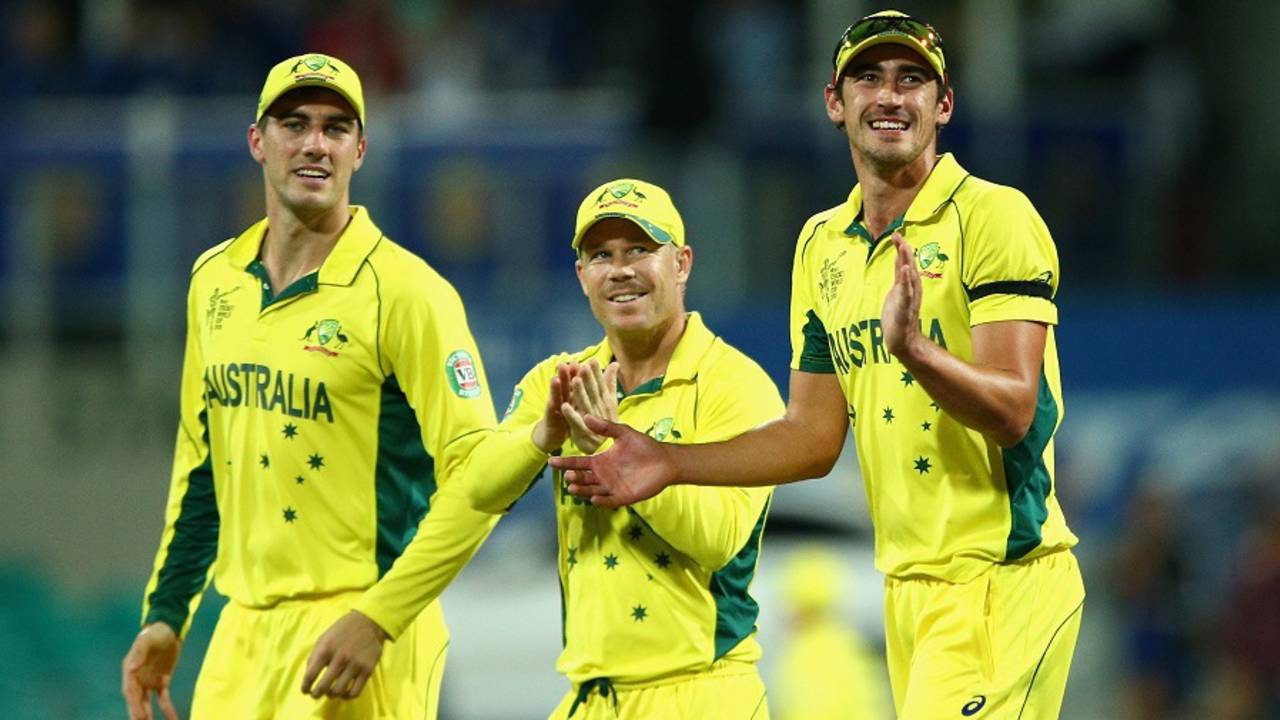Four Australia players India need to beware of and how they should go about dealing with them
David Warner
His ability to play both pace and spin with equal efficiency makes him one of the most dangerous white-ball batsmen of our times. Warner seems to have found a method of scoring at a fast clip without taking too many risks. He is exceptionally strong square of the wicket, and so it is wise to avoid bowling short to him. While bowling a bouncer once in a while is fine, the stock delivery against him should aim to drag him forward. If you bowl at a good length (six to eight metres from the stumps) and finish in the corridor of fourth-to-sixth stump outside off, you will not only keep him quiet but also might dismiss him. The line and length that Jasprit Bumrah bowled to Quinton de Kock in India's first game is the ideal bowling plan to Warner.
If he manages to bat through the first few overs of pace, India shouldn't think twice about bowling Kuldeep Yadav in the Powerplay. The new Warner is a lot more cautious about the way he goes about his business; he has started putting a higher price on his wicket, setting his ego aside. If he is not able to get going initially, he is happy to bide his time, which wasn't the case earlier. Kuldeep, with his slowness in the air and fuller length, might induce him to bin his discipline and try sweeping, reverse-sweeping or switch-hitting.
Steven Smith
Smith has the most unorthodox technique in modern cricket for someone who is so successful. He moves across a lot, and his bat comes down from the direction of point, with the bat face closed. In theory, this should put him at high risk of getting out leg-before against pace, but he rarely gets hit on the pads and there's not much point attacking his legs in the hope of getting an lbw decision.
Bowling fuller and wider, in the line of the seventh or eighth stumps, is a much better option, for he doesn't drive as much. While operating with that line, it's not a bad idea to have a gully in place, for that is where he gets singles to rotate strike.
He does play spin well but since bowling spin to him is unavoidable, India should keep the mid-off or mid-on fielder inside the ring to make him go aerial. He likes milking spinners for singles, so cutting that option out might make him do something that he doesn't like doing early in his innings.
Mitchell Starc
Starc is the kind of wicket-taking bowler you want in your team, not someone you want to be facing. He is seriously fast, and whenever he manages to bring the ball back in, he becomes more lethal.
The quality that separates him from the rest is that his full ball is quicker than the shorter balls he bowls. He will look to pitch the ball full and bring it in to Rohit Sharma - which Trent Boult did perfectly in the
warm-up game. But the way Starc releases the ball - with the wrist at a 45-degree angle, instead of it facing the batsman full-on - most deliveries go with the angle and do not come back in.
Since Starc is a yard quicker than Boult, the ones that angle across the right-hand batsmen are likely to cause concern. I won't be surprised if the Australians attack with a gully in place to the entire Indian top order. They used this strategy against India in
the series that they won before the IPL, and considering it was successful then, it will be surprising if they didn't continue in same fashion in conditions that are far more conducive for fast bowling.
While Shikhar Dhawan got out to Kagiso Rabada's away-going delivery in India's
opening match, it is Starc's full ball that comes in with the angle that he needs to be wary of against Australia. (Remember how Mustafizur Rahman dismissed him in
the other warm-up game - lbw to a full one that angled in?)
The Indian batsmen will also need to be prepared for the generous number of bouncers that will come their way. Starc could be more than handful in the death overs, so it is important for India to make the 31-40 overs phase count.
Pat Cummins
Unlike Starc, Cummins doesn't swing the ball in the air. He is a hit-the-deck-hard bowler who relies on making the ball move laterally off the surface.
There is a lot of talk these days about bowling hard lengths. What exactly does that mean?
A hard length is one where the ball cannot be driven off the front foot, and nor is it short enough to be hit with a horizontal bat. Mostly the ball hits the bat a little higher than the sweet spot, irrespective of the shot the batsman chooses to play. That is the length Cummins bowls most times. He will keep pushing the batsman back, hoping to finally induce a false shot off the front foot when he does go fuller.
Since he is tall and has a high-arm action, he too will bowl a few bouncers. And it goes without saying that he will bowl a fifth-sixth-stump line to Kohli with a gully and slip in place. While Starc will go for yorkers in the death overs, Cummins won't mind bowling short and targeting the ribcage.
